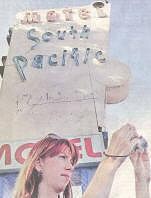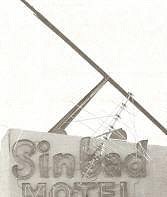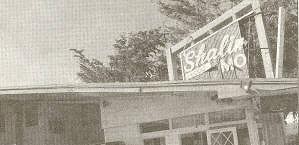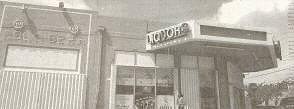Beyond Tiki, Bilge, and Test / Beyond Tiki / Miami Beach Mid-Century Modern officially historic
Post #339432 by I dream of tiki on Fri, Oct 19, 2007 5:36 PM
|
IDOT

I dream of tiki
Posted
posted
on
Fri, Oct 19, 2007 5:36 PM
Biscayne Boulevard Historic District Miami Hopes to Protect Era of Architecture Along BiscaynePosted on Tuesday, March 07, 2006
A SoBe for MiMO? Preserving the Miami modern era could give Biscayne and Art Deco cache For years the Maule building sat forlornly on Biscayne Boulevard at 52nd Street, a hollow shell on borrowed time. Once the headquarters of the Ferre family enterprises, designed to show off the virtues of the family's product -- concrete -- it was considered by architecture experts to be one of the finest buildings of its kind. But in recent years, it was fenced off, its windows knocked out and trashed, its death warrant all but signed. Last week it succumbed to the wrecker. A wooden sign announces the condo tower to come in its place. Yet the 1954 Maule building could be the martyr that propels a new wave of historic preservation in the city. MiMo buildings reflect Miami's adoption of stripped-down, geometric modern design after World War II, an optimistic time when Miami was on the rise, the Rat Pack ran around town, and mass family tourism -- and thus the roadside motel -- was born. The forward-looking buildings feature gravity-defying concrete projections, sun screens made of metal grilles, fancifully shaped concrete blocks. The proposed district, scheduled to receive preliminary consideration from the city's Historic and Environmental Preservation Board today, would encompass both sides of the boulevard from 50th Street to the Little River just north of 77th Street.
LEGAL PROTECTIONS MiMo proponents, who followed the Maule building's march to extinction with consternation, are ecstatic. The district's creation, they say, could help inspire an urban revival to rival Miami Beach's. City preservation officer Kathleen Slesnick Kauffman said the boulevard -- which some have dubbed ''MiMo's Main Street'' -- has the potential to become a lively, walkable and architecturally unique district, Miami's version of Lincoln Road. "Miami is finally going to have its South Beach, with all the different styles in one place,'' said Randall Robinson, a planner and architectural historian. The proposed district caps a three-year effort to protect significant, endangered buildings that began under former preservation director Sarah Eaton, who retired last year. Bill Hopper, president of the Morningside Civic Association, applauded the plan, which he said should help preserve the historic scale of the strip, where condo proposals have drawn opposition from nearby residents. Preservation could, however, provoke opposition from property owners on the long-depressed boulevard who have pinned their hopes on high-rise condos and commercial redevelopment. It could also get a lukewarm reception from skeptics who dismiss MiMo architecture as schlock, the product of an era that built quickly and cheaply. The notion of designating modern buildings as historic has proven divisive even among preservationists, many of whom believe efforts should focus on saving older, traditional buildings. ''I'm sure there is going to be some opposition,'' said Otto Boudet-Murias, the city's chief of planning and economic development. ``But I haven't heard any complaints or any great anxiety yet.'' DEMOLITION NIXED Historic designation would not foreclose additions, renovations or redevelopment along the boulevard. But it would likely bar demolition of significant buildings, including most of the signature MiMo motels, many of which are run-down. All plans for renovations or redevelopment would be reviewed by the preservation board to ensure they respect the boulevard's historic character and low scale. ''It doesn't mean you can't develop it. That's a common misconception,'' Kauffman said. ``We want it developed.'' Doing that the right way, however, will require a strategy that fosters creative renovations and new uses for buildings, said Aristides Millas, an architecture historian and professor at the University of Miami. ''The boulevard has some really juicy buildings that scream at you to get your attention. They're fun buildings, not overly serious buildings,'' said Millas. ``But they're not in very good shape. These pieces of history are important if they can be woven into a coherent plan for the boulevard. The buildings have to have new uses that are economically viable. You can't just save concrete.'' YEARS IN THE MAKING Consideration of the district first arose almost three years ago, when the city hired a consultant to draw up a proposal. But the plan appeared dormant until earlier this year, when the city commission approved a condo project for the Maule building site. Eric Silverman, who is renovating the Vagabond motel, got a sympathetic hearing from commissioners, including Johnny Winton, whose district includes the boulevard, when he complained that other MiMo buildings might soon follow the Maule. Winton subsequently met with city planning officials to consider legal protections. The preservation office has been working on the plan for several weeks, but waited until notices of the proposal went out to property owners to go public, fearing it could provoke demolitions. The notices trigger a moratorium on demolitions and new building permits in the proposed district while the preservation board weighs the plan. A final vote could come in April. In considering the district, Miami is catching up to Miami Beach, which has already established historic districts that include numerous buildings from the 1950s. The Beach is also considering a district along Collins Avenue that would safeguard two of MiMo's crown jewels, architect Morris Lapidus' Fontainebleau and Eden Roc hotels. But many MiMo buildings have just begun reaching the 50-year mark that qualifies them for historic designation. ''It really defines Miami,'' said interior designer Teri D'Amico, who coined the tern ''MiMo.'' ``That was our Golden Age. It was a time when America shone and we were coming up with something unique.'' Copyright 2006 Knight Ridder MiMo Biscayne Association Phone 305-758-6144 Email: [ Edited by: I dream of tiki 2007-10-19 17:37 ] |





